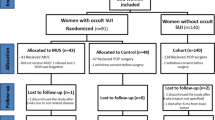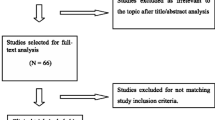Abstract
Introduction and hypothesis
We compared outcomes after midurethral sling (MUS) with and without concomitant repair for prolapse.
Methods
Women who underwent MUS with or without concomitant repair for prolapse completed a follow-up survey. Outcomes were assessed with validated questionnaires and medical record review. Kaplan–Meier, Cox proportional hazards regression, and logistic regression models were used for analysis.
Results
Of 317 women, 281 (89%) responded to the survey. During a median follow-up of 2.7 years, survival free of “any” incontinence (Incontinence Severity Index score, >0) was similar in both groups (adjusted hazard ratio, 1.07; P = 0.77). Women with concomitant repair for advanced prolapse tended to be more bothered by frequent urination (adjusted odds ratio, 1.78; P = 0.08) and more likely to require urethrolysis (odds ratio, 6.11; P = 0.04) than those without concomitant pelvic floor repair.
Conclusions
Prolapse repairs concomitant with MUS did not affect incontinence recurrence. However, repairs may cause increased lower urinary tract symptoms.

Similar content being viewed by others
Abbreviations
- BMI:
-
Body mass index
- ISI:
-
Incontinence Severity Index
- LUTS:
-
Lower urinary tract symptoms
- MUS:
-
Midurethral sling
- OR:
-
Odds ratio
- SUI:
-
Stress urinary incontinence
References
Richter HE, Nygaard I, Burgio KL, Handa VL, Fitzgerald MP, Wren P, Pelvic Floor Disorders Network et al (2007) Lower urinary tract symptoms, quality of life and pelvic organ prolapse: irritative bladder and obstructive voiding symptoms in women planning to undergo abdominal sacrocolpopexy for advanced pelvic organ prolapse. J Urol 178:965–969
Lo TS (2004) Tension-free vaginal tape procedures in women with stress urinary incontinence with and without co-existing genital prolapse. Curr Opin Obstet Gynecol 16:399–404
Pang MW, Chan LW, Yip SK (2003) One-year urodynamic outcome and quality of life in patients with concomitant tension-free vaginal tape during pelvic floor reconstruction surgery for genitourinary prolapse and urodynamic stress incontinence. Int Urogynecol J Pelvic Floor Dysfunct 14:256–260
Rafii A, Paoletti X, Haab F, Levardon M, Deval B (2004) Tension-free vaginal tape and associated procedures: a case control study. Eur Urol 45:356–361
Trabuco EC, Klingele CJ, Weaver AL, McGree ME, Lightner DJ, Gebhart JB (2009) Medium-term comparison of continence rates after rectus fascia or midurethral sling placement. Am J Obstet Gynecol 200:300.e1–300.e6
Baden WF, Walker TA (1972) Genesis of the vaginal profile: a correlated classification of vaginal relaxation. Clin Obstet Gynecol 15:1048–1054
Ulmsten U, Henriksson L, Johnson P, Varhos G (1996) An ambulatory surgical procedure under local anesthesia for treatment of female urinary incontinence. Int Urogynecol J Pelvic Floor Dysfunct 7:81–85
Webb MJ, Aronson MP, Ferguson LK, Lee RA (1998) Posthysterectomy vaginal vault prolapse: primary repair in 693 patients. Obstet Gynecol 92:281–285
Lee RA (1992) Atlas of gynecologic surgery. Saunders, Philadelphia
Ward K, Hilton P, United Kingdom and Ireland Tension-free Vaginal Tape Trial Group (2002) Prospective multicentre randomised trial of tension-free vaginal tape and colposuspension as primary treatment for stress incontinence. BMJ 325:67
Lo TS, Chang TC, Chao AS, Chou HH, Tseng LH, Liang CC (2003) Tension-free vaginal tape procedure on genuine stress incontinent women with coexisting genital prolapse. Acta Obstet Gynecol Scand 82:1049–1053
Groutz A, Gold R, Pauzner D, Lessing JB, Gordon D (2004) Tension-free vaginal tape (TVT) for the treatment of occult stress urinary incontinence in women undergoing prolapse repair: a prospective study of 100 consecutive cases. Neurourol Urodyn 23:632–635
Meschia M, Pifarotti P, Spennacchio M, Buonaguidi A, Gattei U, Somigliana E (2004) A randomized comparison of tension-free vaginal tape and endopelvic fascia plication in women with genital prolapse and occult stress urinary incontinence. Am J Obstet Gynecol 190:609–613
Partoll LM (2002) Efficacy of tension-free vaginal tape with other pelvic reconstructive surgery. Am J Obstet Gynecol 186:1292–1295
Huang KH, Kung FT, Liang HM, Chen CW, Chang SY, Hwang LL (2006) Concomitant pelvic organ prolapse surgery with TVT procedure. Int Urogynecol J Pelvic Floor Dysfunct 17:60–65
Anger JT, Litwin MS, Wang Q, Pashos CL, Rodríguez LV (2008) The effect of concomitant prolapse repair on sling outcomes. J Urol 180:1003–1006
Brubaker L, Cundiff GW, Fine P, Nygaard I, Richter HE, Visco AG, Pelvic Floor Disorders Network et al (2006) Abdominal sacrocolpopexy with Burch colposuspension to reduce urinary stress incontinence. N Engl J Med 354:1557–1566
Sandvik H, Hunskaar S, Seim A, Hermstad R, Vanvik A, Bratt H (1993) Validation of a severity index in female urinary incontinence and its implementation in an epidemiological survey. J Epidemiol Community Health 47:497–499
Conflicts of interest
None.
Author information
Authors and Affiliations
Corresponding author
Rights and permissions
About this article
Cite this article
Casiano, E.R., Gebhart, J.B., McGree, M.E. et al. Does concomitant prolapse repair at the time of midurethral sling affect recurrent rates of incontinence?. Int Urogynecol J 22, 819–825 (2011). https://doi.org/10.1007/s00192-011-1367-6
Received:
Accepted:
Published:
Issue Date:
DOI: https://doi.org/10.1007/s00192-011-1367-6




